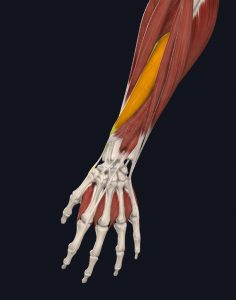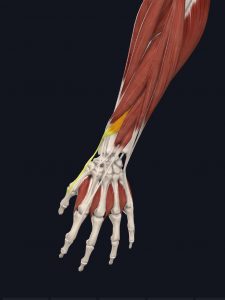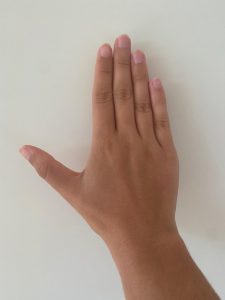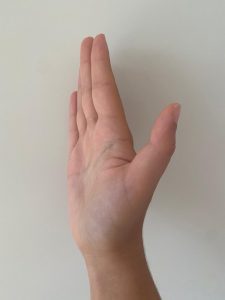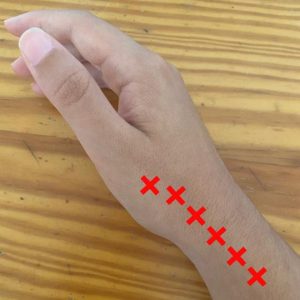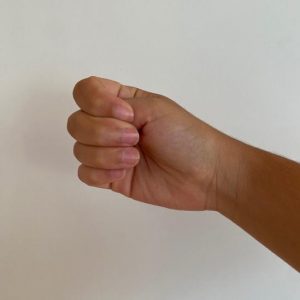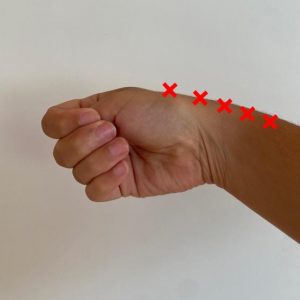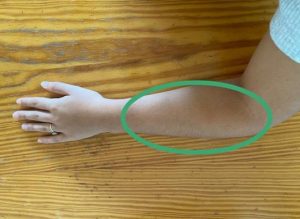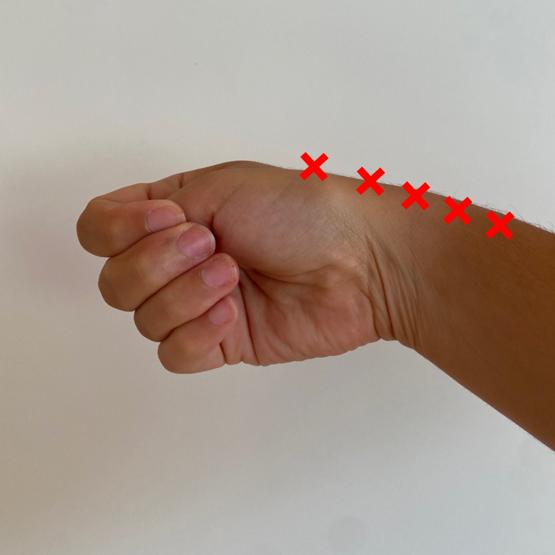
Developing a sharp pain on the back of your thumb or wrist? Is it limiting your ability to type, lift and hold items, and do your everyday activities?
You might have developed an injury called DeQuervain’s Syndrome. It can also be called a synovitis or tenosynovitis depending on which specific structure is inflamed.
If you need help managing your symptoms, JACO Rehab has your back! We can help you understand and treat your condition. If you’re on Oahu, book an appointment with us today.
What is DeQuervain’s Synovitis?
Your fingers are controlled by muscles that attach on the forearm or near your elbow. Those muscles have tendons that travel through the wrist and attach to your fingers.
Your wrist is small relative to the number of structures that run through it. It must direct the traffic, so it organizes the structures into different “tunnels”.
DeQuervain’s is the irritation of extensor tunnel number one, located at the base of your thumb on the backside of your wrist.
Tunnel one directs two tendons which control thumb movement, specifically the extensor pollicis brevis and abductor pollicis longus.
- Abductor Pollicis Longus
- Extensor Pollicis Brevis
Images Courtesy of Complete Anatomy
The abductor pollicis longus helps move the thumb away from the other fingers. The extensor pollicis brevis helps move the thumb in backwards from a forward position.
- Abduction (moving thumb away)
- Extension (moving thumb back)
What Are the Symptoms?
Symptoms vary in frequency and intensity, but it will always involve pain and discomfort located in the back of your wrist toward the base of your thumb.
Your symptoms may start out as come-and-go pain, but it can develop into constant irritation that can disturb sleep and daily routine.
In some cases, you may find swelling at the base of your thumb accompanied with your pain.
The Finklestein Test
You can test if you have DeQuervain’s by doing a simple movement!
- Tuck your thumb into your fist (if this hurts, stop here)
- Angle your wrist downward
- Tuck thumb
- Angle wrist downward
If that movement reproduces your pain, then it is a positive test which means you likely have the condition.
Who Can Develop DeQuervain’s Synovitis?
Since DeQuervain’s is an overuse injury, activities that require repetitive movements of the thumb or wrist will increase your chance of developing DeQuervain’s.
These activities include: (5)
- Typing and texting
- Repetitive wringing or grabbing motions
- Frequent carrying and lifting
- Too many thumb wars
Most people who we see in the clinic with DeQuervain’s include:
- New mothers tending to their newborns, often painful on both hands (5)
- Office workers
- Bartenders/servers
- Carpenters
Generally, vulnerable populations fall into these categories: (5)
- Over 2x more females than males
- 40-50s age range
- Those with a history of golfer’s or tennis elbow (medial or lateral epicondylitis)
How Do I Manage My Symptoms?
Once to recognize your symptoms, you’ll want to get it examined before it affects your sleep and daily life.
Your doctor will likely give you a few treatment options. Mild to moderate cases will require conservative management first. If you’ve tried everything with no resolution, your doctor may advise surgery.
No matter the management technique, there’s a likelihood that your symptoms can return after they’ve been resolved. It’s recommended to avoid repetitive movements during your healing time and address the reason why your tendons are being overused.
Management for DeQuervain’s Synovitis: Exercises and Splinting
You’ll want to try conservative management first.
Physical therapy will help you decrease irritation and learn exercises that will reverse your symptoms. You can book an appointment with JACO and start resolving your pain!
Your therapist may advise you to massage the involved musculature at the muscle belly to decrease pain at the tendon. Initially, you want to avoid massaging directly over the inflamed tendon as it may increase pain instead.
- Massage here!
He/she may also advise exercises that target muscles closer to the center of the body to offload the thumb. For example, a weak shoulder could force other muscles (like wrist and thumb muscles) to compensate when lifting or carrying objects. Research has shown that this is the case for tennis elbow and is likely the case for other overuse injuries in the periphery as well. (1)
You’ll also find it helpful to splint your thumb, especially at night. When you immobilize it, you keep it safe from further overuse. Look for “thumb splicas” at the store.
Once your symptom irritability decreases, you’ll wean from your splint and start tolerating light strengthening exercises of the thumb. You should stay away from stretching at the beginning, as stretching irritated tendons will increase pain.
If you don’t notice any improvement after the first round of therapy, your doctor may recommend another approach.
Management for DeQuervain’s Synovitis: Injections
If your symptoms are sticking around, your doctor may order corticosteroid injections to fight off the pain and inflammation.
Symptoms typically reduce after 1-2 injections. (5)
Even though your pain has decreased, the root cause of your symptoms has not been addressed. Your symptoms can return if you do not find the reason why they began.
Example: Has your therapist discovered weakness at the shoulder or elbow that could be causing compensation at the wrist and thumb? Make sure you keep addressing this problem.
If your pain returns, more injections are not always the answer. Like any medication, steroid injections can have some gnarly side effects, especially when used over a long period of time. (2, 4)
Instead, your doctor may recommend surgery.
Management for DeQuervain’s Synovitis: Surgery
Surgery is only reserved for unrelenting cases.
When tendons or the surrounding sheath are irritated, they are more sensitive to friction from other tissues. Swelling can enclose the area which makes it worse. In chronic cases, the tendon sheath will become thicker, further trapping the tendons from pain-free mobility in their tunnel.
If both physical therapy and 1-2 injections have not worked, the next option could be to release the tendon from the surrounding tissue.
It’s a quick procedure that cuts through the skin to the ligament housing the tendons. The ligament is released, which allows the tendons to breathe.
After surgery, your doctor will give you a specific protocol to follow. Further physical therapy may be recommended depending on your unique needs.
Of course, there are risks. It shouldn’t be the first line treatment.
Risks include: (5)
- Injury to the superficial radial nerve, which alters sensation
- Tendon subluxation with certain wrist movements, which causes irritation
What to Avoid with DeQuervain’s Synovitis
The simple (but annoying) answer? Don’t do anything that makes it feel worse.
Initially, things that make DeQuervain’s worse include:
- Continuing the same repetitive movements/activities: You don’t want to continue the same painful activities!
- Massaging directly over the painful tendon: This could be irritating to tendons initially but could be tolerated later.
- Stretching the tendons: Painful tendons and tissues generally do not respond well to stretch and may become more painful.
- Over-icing: Icing can delay the inflammation process which delays healing, but it does improve pain levels. If you must ice, small bouts of 5 minutes are best, then wean off ice in the first few days. (3)
Even though you want to avoid painful movements and activities, you don’t want to completely rest the thumb and wrist. There’s a delicate balance between movement and avoidance.
Complete rest would decondition the area and create fear around movement. That can be detrimental to healing.
Instead, move your thumb and wrist as tolerated. Ask your physical therapist for pain-free movement ideas that you can perform at home – in fact, it could speed up your healing!
On that note, here’s what you SHOULD do if you suspect to have DeQuervain’s Synovitis:
- Stop the painful activity, if possible.
- Go to physical therapy and get evaluated.
- Get a thumb splica and wear as recommended by your therapist, if appropriate.
- Do the home exercise program that your therapist prescribes.
- Start feeling better!
Get Treatment
Don’t wait – get started with physical therapy! The earlier you address the condition, the better. Book an appointment at JACO Rehab today.
Cited Resources
- Day JM, Lucado AM, Uhl TL. A COMPREHENSIVE REHABILITATION PROGRAM FOR TREATING LATERAL ELBOW TENDINOPATHY. Int J Sports Phys Ther. 2019 Sep;14(5):818-829. PMID: 31598419; PMCID: PMC6769266
- Haraldsson BT, Langberg H, Aagaard P, et al. Corticosteroids Reduce the Tensile Strength of Isolated Collagen Fascicles. The American Journal of Sports Medicine. 2006;34(12):1992-1997. doi:10.1177/0363546506290402
- Mirkin, G. (2015, September). Why ice delays recovery. Dr Gabe Mirkin on Health. Retrieved from www.drmirkin.com/fitness/why-ice-delays-recovery.html
- Puzzitiello, R. N., Patel, B. H., Forlenza, E. M., Nwachukwu, B. U., Allen, A. A., Forsythe, B., & Salzler, M. J. (2020, April 8). Adverse impact of corticosteroids on rotator cuff tendon health and repair: A systematic review of Basic Science Studies. Arthroscopy, Sports Medicine, and Rehabilitation. Retrieved August 6, 2022, from https://www.sciencedirect.com/science/article/pii/S2666061X20300031
- Satteson E, Tannan SC. De Quervain Tenosynovitis. [Updated 2022 Feb 22]. In: StatPearls [Internet]. Treasure Island (FL): StatPearls Publishing; 2022 Jan-. Available from: https://www.ncbi.nlm.nih.gov/books/NBK442005/
